Strategies for Opioid Harm Prevention: A Public Policy Meeting
VerifiedAdded on 2023/04/03
|8
|1349
|242
Report
AI Summary
This report summarizes a public policy meeting focused on opioid harm prevention, addressing the rising rates of opioid abuse and misuse in the United States. The meeting's purpose was to devise strategies to mitigate the harms caused by opioids, with key participants including representatives from the WHO, FDA, pharmaceutical companies, government, and marketers. The main agendas included outlining the harms caused by opioids, understanding the reasons for increased opioid use, and developing legislative and educational strategies to prevent opioid side effects. The committee discussed legislative policies concerning physical and mental health examinations, doctor shopping laws, pain management regulations, and drug prescription laws, alongside educational strategies to raise public awareness about safe drug storage, use, and disposal. Key stakeholders, such as law enforcement, the public, medical officers, and families, were considered in the discussion. The meeting concluded with recommendations for stricter regulations on opioid prescription, supply, and demand, emphasizing the need for mental health evaluations before prescribing opioids and educating prescribers on alternative pain management methods. The stakeholders classified the policy into two approaches for the prevention of drug abuse and misuse and interventions strategies meant to promote access services supporting drug abuse.
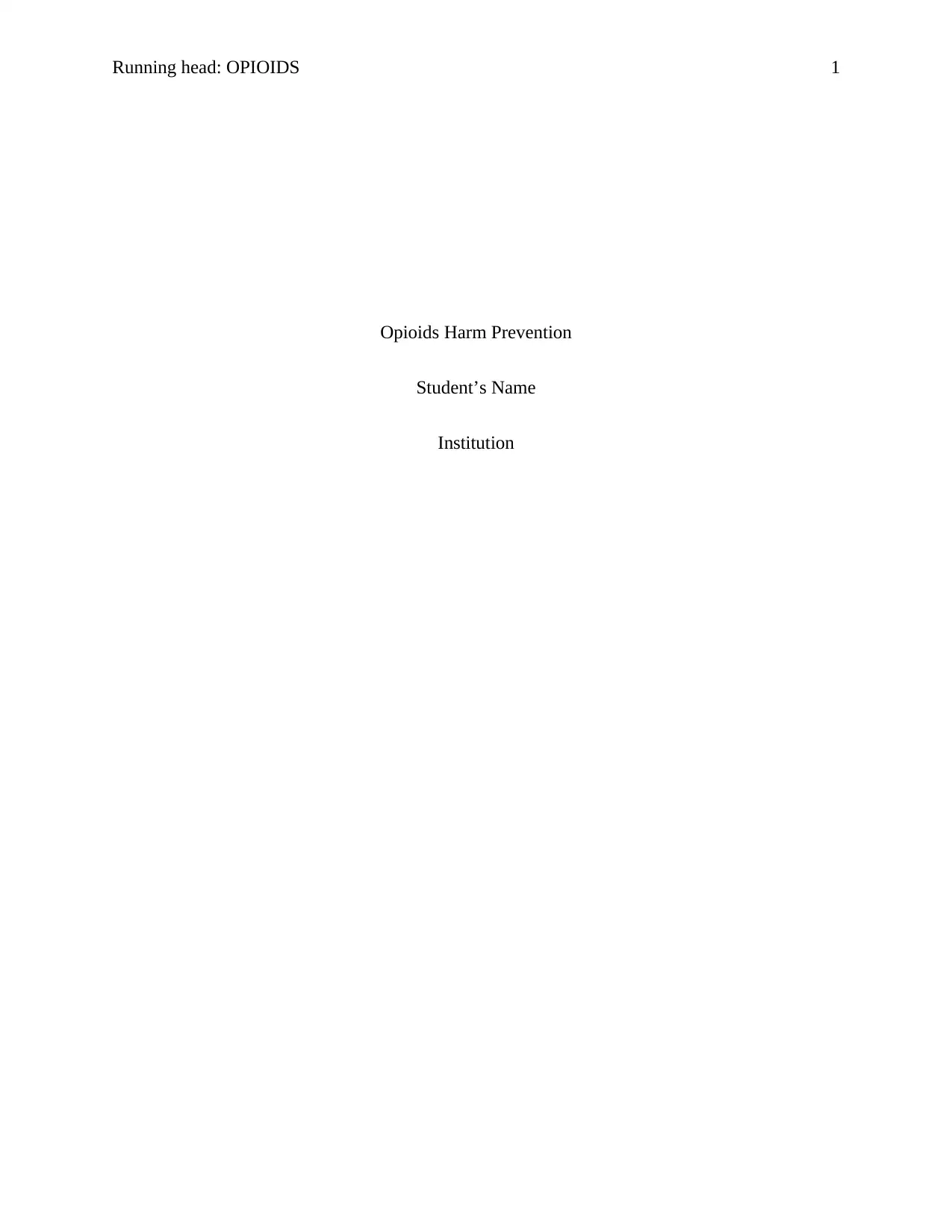
Running head: OPIOIDS 1
Opioids Harm Prevention
Student’s Name
Institution
Opioids Harm Prevention
Student’s Name
Institution
Paraphrase This Document
Need a fresh take? Get an instant paraphrase of this document with our AI Paraphraser
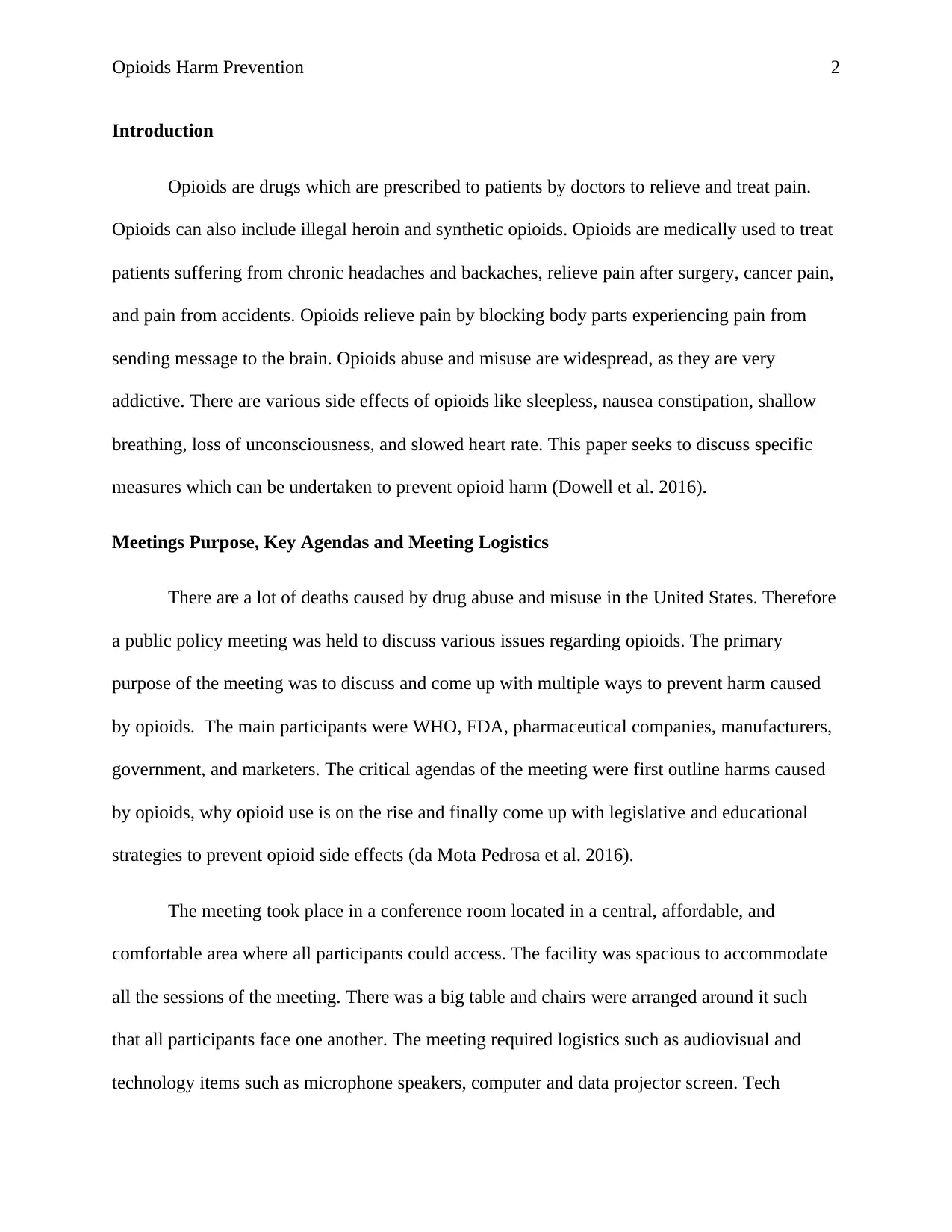
Opioids Harm Prevention 2
Introduction
Opioids are drugs which are prescribed to patients by doctors to relieve and treat pain.
Opioids can also include illegal heroin and synthetic opioids. Opioids are medically used to treat
patients suffering from chronic headaches and backaches, relieve pain after surgery, cancer pain,
and pain from accidents. Opioids relieve pain by blocking body parts experiencing pain from
sending message to the brain. Opioids abuse and misuse are widespread, as they are very
addictive. There are various side effects of opioids like sleepless, nausea constipation, shallow
breathing, loss of unconsciousness, and slowed heart rate. This paper seeks to discuss specific
measures which can be undertaken to prevent opioid harm (Dowell et al. 2016).
Meetings Purpose, Key Agendas and Meeting Logistics
There are a lot of deaths caused by drug abuse and misuse in the United States. Therefore
a public policy meeting was held to discuss various issues regarding opioids. The primary
purpose of the meeting was to discuss and come up with multiple ways to prevent harm caused
by opioids. The main participants were WHO, FDA, pharmaceutical companies, manufacturers,
government, and marketers. The critical agendas of the meeting were first outline harms caused
by opioids, why opioid use is on the rise and finally come up with legislative and educational
strategies to prevent opioid side effects (da Mota Pedrosa et al. 2016).
The meeting took place in a conference room located in a central, affordable, and
comfortable area where all participants could access. The facility was spacious to accommodate
all the sessions of the meeting. There was a big table and chairs were arranged around it such
that all participants face one another. The meeting required logistics such as audiovisual and
technology items such as microphone speakers, computer and data projector screen. Tech
Introduction
Opioids are drugs which are prescribed to patients by doctors to relieve and treat pain.
Opioids can also include illegal heroin and synthetic opioids. Opioids are medically used to treat
patients suffering from chronic headaches and backaches, relieve pain after surgery, cancer pain,
and pain from accidents. Opioids relieve pain by blocking body parts experiencing pain from
sending message to the brain. Opioids abuse and misuse are widespread, as they are very
addictive. There are various side effects of opioids like sleepless, nausea constipation, shallow
breathing, loss of unconsciousness, and slowed heart rate. This paper seeks to discuss specific
measures which can be undertaken to prevent opioid harm (Dowell et al. 2016).
Meetings Purpose, Key Agendas and Meeting Logistics
There are a lot of deaths caused by drug abuse and misuse in the United States. Therefore
a public policy meeting was held to discuss various issues regarding opioids. The primary
purpose of the meeting was to discuss and come up with multiple ways to prevent harm caused
by opioids. The main participants were WHO, FDA, pharmaceutical companies, manufacturers,
government, and marketers. The critical agendas of the meeting were first outline harms caused
by opioids, why opioid use is on the rise and finally come up with legislative and educational
strategies to prevent opioid side effects (da Mota Pedrosa et al. 2016).
The meeting took place in a conference room located in a central, affordable, and
comfortable area where all participants could access. The facility was spacious to accommodate
all the sessions of the meeting. There was a big table and chairs were arranged around it such
that all participants face one another. The meeting required logistics such as audiovisual and
technology items such as microphone speakers, computer and data projector screen. Tech
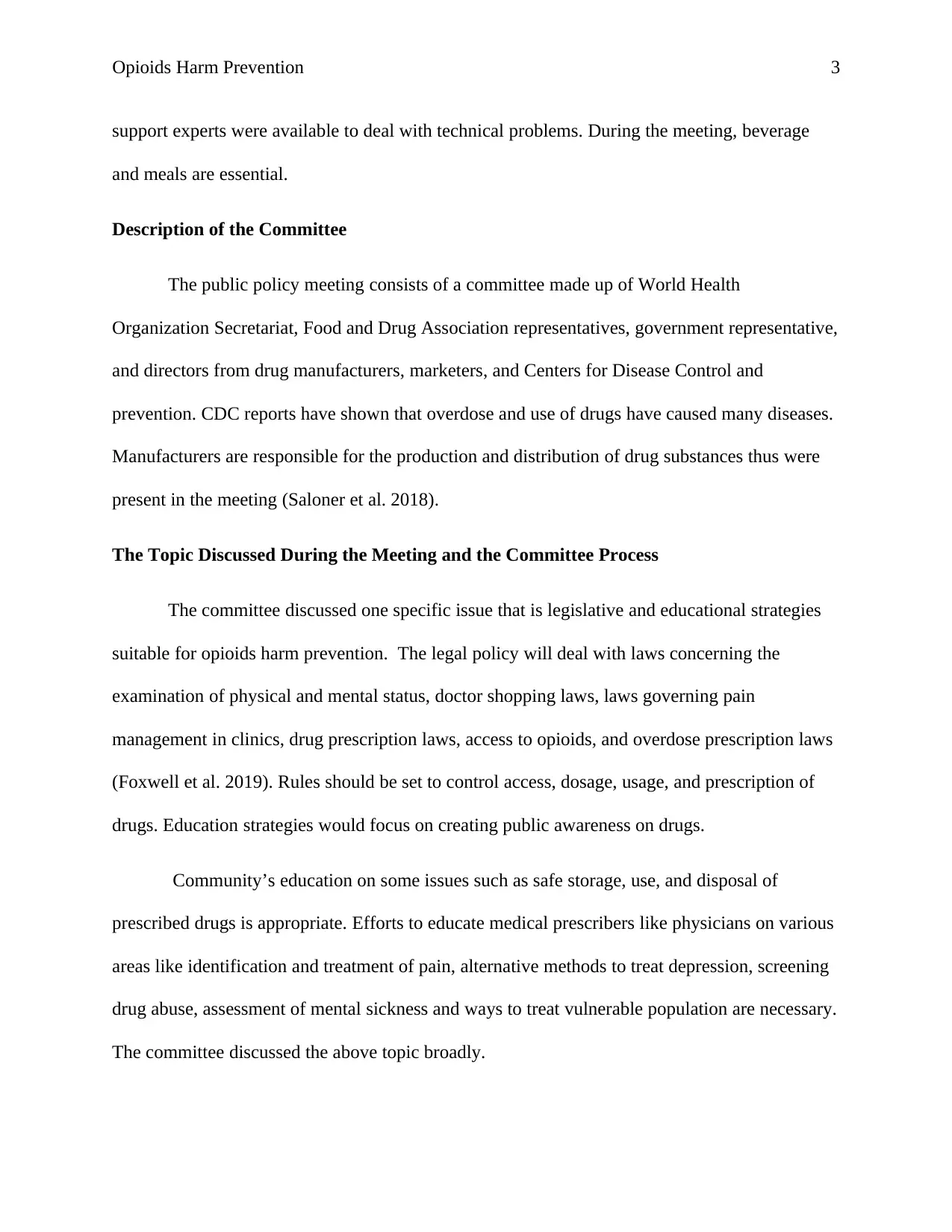
Opioids Harm Prevention 3
support experts were available to deal with technical problems. During the meeting, beverage
and meals are essential.
Description of the Committee
The public policy meeting consists of a committee made up of World Health
Organization Secretariat, Food and Drug Association representatives, government representative,
and directors from drug manufacturers, marketers, and Centers for Disease Control and
prevention. CDC reports have shown that overdose and use of drugs have caused many diseases.
Manufacturers are responsible for the production and distribution of drug substances thus were
present in the meeting (Saloner et al. 2018).
The Topic Discussed During the Meeting and the Committee Process
The committee discussed one specific issue that is legislative and educational strategies
suitable for opioids harm prevention. The legal policy will deal with laws concerning the
examination of physical and mental status, doctor shopping laws, laws governing pain
management in clinics, drug prescription laws, access to opioids, and overdose prescription laws
(Foxwell et al. 2019). Rules should be set to control access, dosage, usage, and prescription of
drugs. Education strategies would focus on creating public awareness on drugs.
Community’s education on some issues such as safe storage, use, and disposal of
prescribed drugs is appropriate. Efforts to educate medical prescribers like physicians on various
areas like identification and treatment of pain, alternative methods to treat depression, screening
drug abuse, assessment of mental sickness and ways to treat vulnerable population are necessary.
The committee discussed the above topic broadly.
support experts were available to deal with technical problems. During the meeting, beverage
and meals are essential.
Description of the Committee
The public policy meeting consists of a committee made up of World Health
Organization Secretariat, Food and Drug Association representatives, government representative,
and directors from drug manufacturers, marketers, and Centers for Disease Control and
prevention. CDC reports have shown that overdose and use of drugs have caused many diseases.
Manufacturers are responsible for the production and distribution of drug substances thus were
present in the meeting (Saloner et al. 2018).
The Topic Discussed During the Meeting and the Committee Process
The committee discussed one specific issue that is legislative and educational strategies
suitable for opioids harm prevention. The legal policy will deal with laws concerning the
examination of physical and mental status, doctor shopping laws, laws governing pain
management in clinics, drug prescription laws, access to opioids, and overdose prescription laws
(Foxwell et al. 2019). Rules should be set to control access, dosage, usage, and prescription of
drugs. Education strategies would focus on creating public awareness on drugs.
Community’s education on some issues such as safe storage, use, and disposal of
prescribed drugs is appropriate. Efforts to educate medical prescribers like physicians on various
areas like identification and treatment of pain, alternative methods to treat depression, screening
drug abuse, assessment of mental sickness and ways to treat vulnerable population are necessary.
The committee discussed the above topic broadly.
⊘ This is a preview!⊘
Do you want full access?
Subscribe today to unlock all pages.

Trusted by 1+ million students worldwide
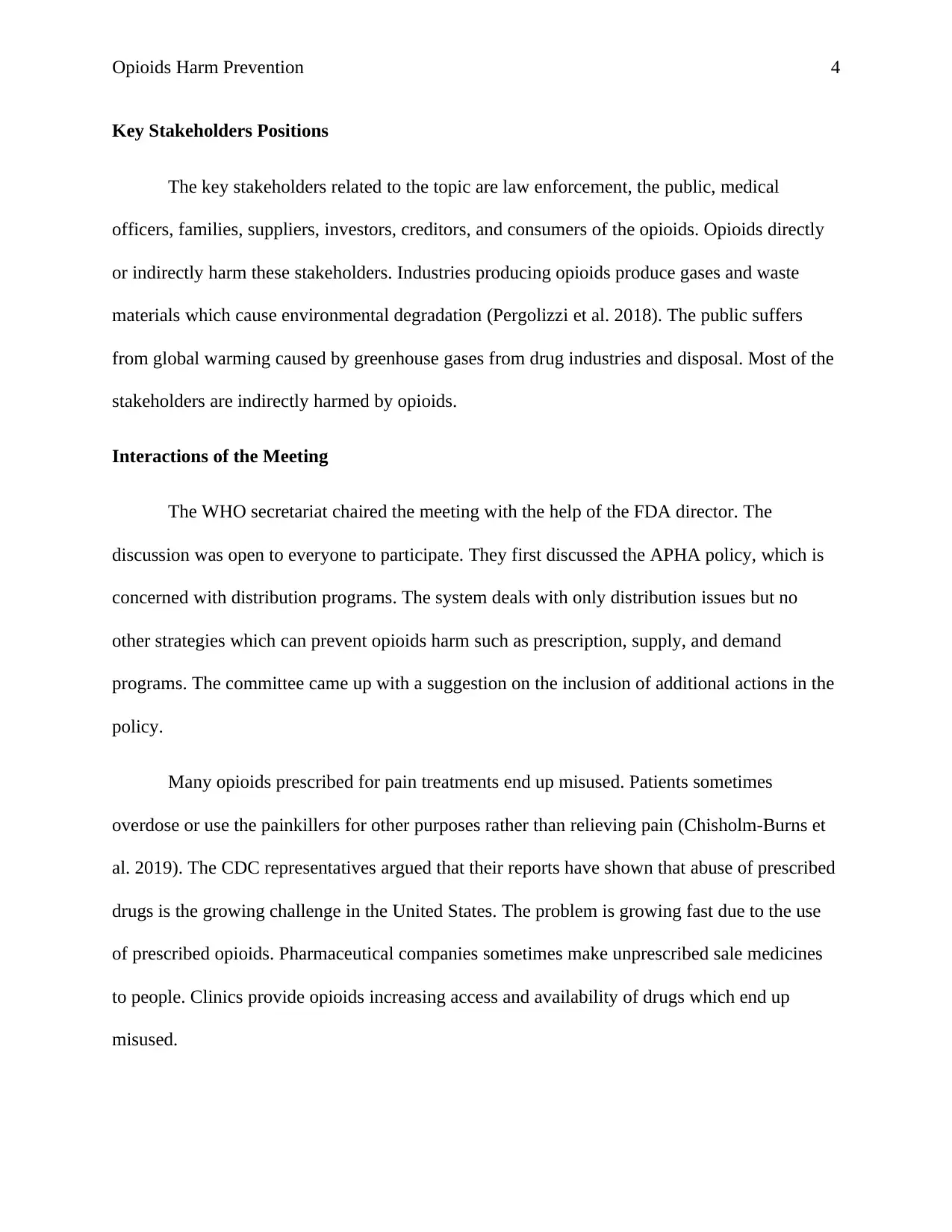
Opioids Harm Prevention 4
Key Stakeholders Positions
The key stakeholders related to the topic are law enforcement, the public, medical
officers, families, suppliers, investors, creditors, and consumers of the opioids. Opioids directly
or indirectly harm these stakeholders. Industries producing opioids produce gases and waste
materials which cause environmental degradation (Pergolizzi et al. 2018). The public suffers
from global warming caused by greenhouse gases from drug industries and disposal. Most of the
stakeholders are indirectly harmed by opioids.
Interactions of the Meeting
The WHO secretariat chaired the meeting with the help of the FDA director. The
discussion was open to everyone to participate. They first discussed the APHA policy, which is
concerned with distribution programs. The system deals with only distribution issues but no
other strategies which can prevent opioids harm such as prescription, supply, and demand
programs. The committee came up with a suggestion on the inclusion of additional actions in the
policy.
Many opioids prescribed for pain treatments end up misused. Patients sometimes
overdose or use the painkillers for other purposes rather than relieving pain (Chisholm-Burns et
al. 2019). The CDC representatives argued that their reports have shown that abuse of prescribed
drugs is the growing challenge in the United States. The problem is growing fast due to the use
of prescribed opioids. Pharmaceutical companies sometimes make unprescribed sale medicines
to people. Clinics provide opioids increasing access and availability of drugs which end up
misused.
Key Stakeholders Positions
The key stakeholders related to the topic are law enforcement, the public, medical
officers, families, suppliers, investors, creditors, and consumers of the opioids. Opioids directly
or indirectly harm these stakeholders. Industries producing opioids produce gases and waste
materials which cause environmental degradation (Pergolizzi et al. 2018). The public suffers
from global warming caused by greenhouse gases from drug industries and disposal. Most of the
stakeholders are indirectly harmed by opioids.
Interactions of the Meeting
The WHO secretariat chaired the meeting with the help of the FDA director. The
discussion was open to everyone to participate. They first discussed the APHA policy, which is
concerned with distribution programs. The system deals with only distribution issues but no
other strategies which can prevent opioids harm such as prescription, supply, and demand
programs. The committee came up with a suggestion on the inclusion of additional actions in the
policy.
Many opioids prescribed for pain treatments end up misused. Patients sometimes
overdose or use the painkillers for other purposes rather than relieving pain (Chisholm-Burns et
al. 2019). The CDC representatives argued that their reports have shown that abuse of prescribed
drugs is the growing challenge in the United States. The problem is growing fast due to the use
of prescribed opioids. Pharmaceutical companies sometimes make unprescribed sale medicines
to people. Clinics provide opioids increasing access and availability of drugs which end up
misused.
Paraphrase This Document
Need a fresh take? Get an instant paraphrase of this document with our AI Paraphraser
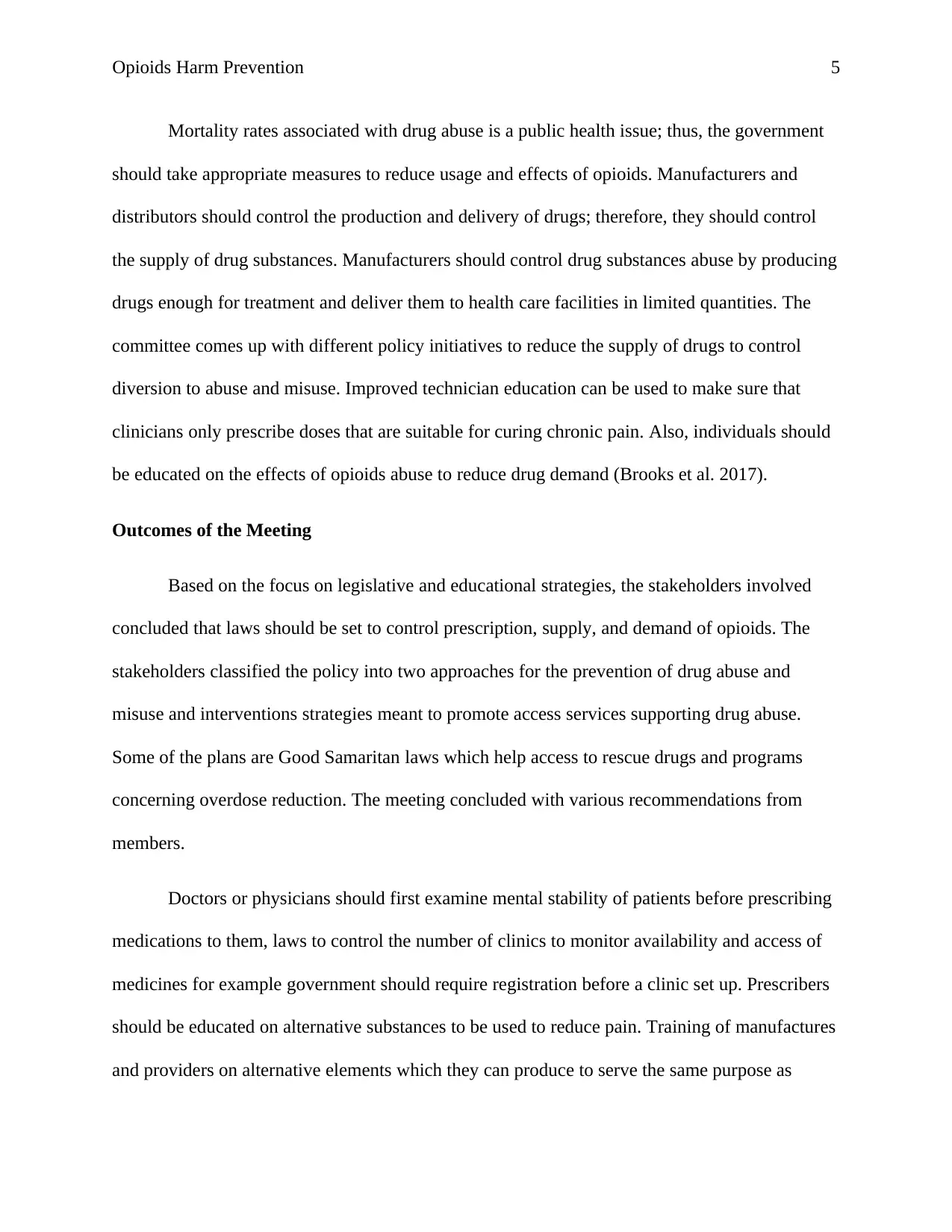
Opioids Harm Prevention 5
Mortality rates associated with drug abuse is a public health issue; thus, the government
should take appropriate measures to reduce usage and effects of opioids. Manufacturers and
distributors should control the production and delivery of drugs; therefore, they should control
the supply of drug substances. Manufacturers should control drug substances abuse by producing
drugs enough for treatment and deliver them to health care facilities in limited quantities. The
committee comes up with different policy initiatives to reduce the supply of drugs to control
diversion to abuse and misuse. Improved technician education can be used to make sure that
clinicians only prescribe doses that are suitable for curing chronic pain. Also, individuals should
be educated on the effects of opioids abuse to reduce drug demand (Brooks et al. 2017).
Outcomes of the Meeting
Based on the focus on legislative and educational strategies, the stakeholders involved
concluded that laws should be set to control prescription, supply, and demand of opioids. The
stakeholders classified the policy into two approaches for the prevention of drug abuse and
misuse and interventions strategies meant to promote access services supporting drug abuse.
Some of the plans are Good Samaritan laws which help access to rescue drugs and programs
concerning overdose reduction. The meeting concluded with various recommendations from
members.
Doctors or physicians should first examine mental stability of patients before prescribing
medications to them, laws to control the number of clinics to monitor availability and access of
medicines for example government should require registration before a clinic set up. Prescribers
should be educated on alternative substances to be used to reduce pain. Training of manufactures
and providers on alternative elements which they can produce to serve the same purpose as
Mortality rates associated with drug abuse is a public health issue; thus, the government
should take appropriate measures to reduce usage and effects of opioids. Manufacturers and
distributors should control the production and delivery of drugs; therefore, they should control
the supply of drug substances. Manufacturers should control drug substances abuse by producing
drugs enough for treatment and deliver them to health care facilities in limited quantities. The
committee comes up with different policy initiatives to reduce the supply of drugs to control
diversion to abuse and misuse. Improved technician education can be used to make sure that
clinicians only prescribe doses that are suitable for curing chronic pain. Also, individuals should
be educated on the effects of opioids abuse to reduce drug demand (Brooks et al. 2017).
Outcomes of the Meeting
Based on the focus on legislative and educational strategies, the stakeholders involved
concluded that laws should be set to control prescription, supply, and demand of opioids. The
stakeholders classified the policy into two approaches for the prevention of drug abuse and
misuse and interventions strategies meant to promote access services supporting drug abuse.
Some of the plans are Good Samaritan laws which help access to rescue drugs and programs
concerning overdose reduction. The meeting concluded with various recommendations from
members.
Doctors or physicians should first examine mental stability of patients before prescribing
medications to them, laws to control the number of clinics to monitor availability and access of
medicines for example government should require registration before a clinic set up. Prescribers
should be educated on alternative substances to be used to reduce pain. Training of manufactures
and providers on alternative elements which they can produce to serve the same purpose as

Opioids Harm Prevention 6
opioids. Opioids harm countries economy; thus, the government should set up regulations to
control abuse and misuse of drug substances (Hawk et al. 2015).
opioids. Opioids harm countries economy; thus, the government should set up regulations to
control abuse and misuse of drug substances (Hawk et al. 2015).
⊘ This is a preview!⊘
Do you want full access?
Subscribe today to unlock all pages.

Trusted by 1+ million students worldwide
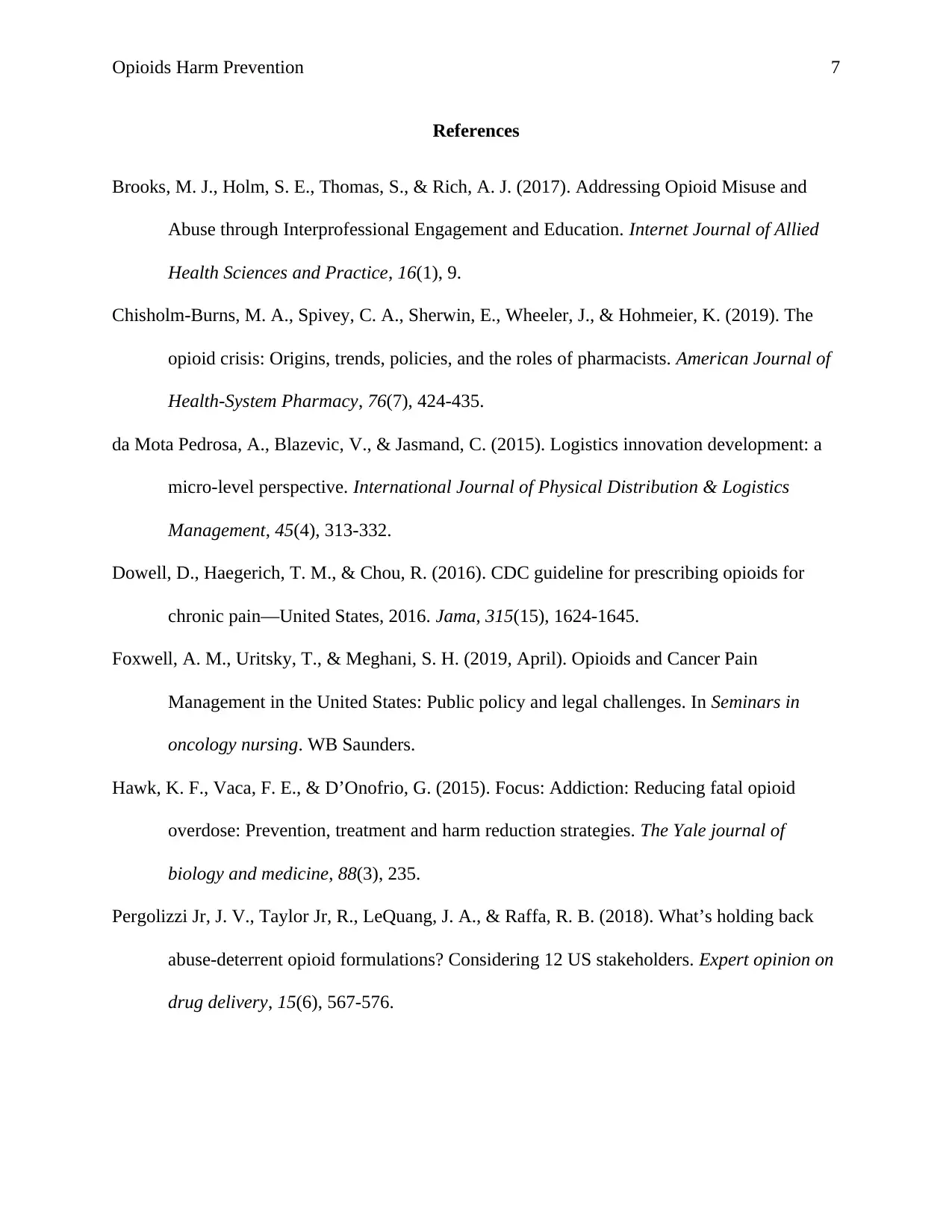
Opioids Harm Prevention 7
References
Brooks, M. J., Holm, S. E., Thomas, S., & Rich, A. J. (2017). Addressing Opioid Misuse and
Abuse through Interprofessional Engagement and Education. Internet Journal of Allied
Health Sciences and Practice, 16(1), 9.
Chisholm-Burns, M. A., Spivey, C. A., Sherwin, E., Wheeler, J., & Hohmeier, K. (2019). The
opioid crisis: Origins, trends, policies, and the roles of pharmacists. American Journal of
Health-System Pharmacy, 76(7), 424-435.
da Mota Pedrosa, A., Blazevic, V., & Jasmand, C. (2015). Logistics innovation development: a
micro-level perspective. International Journal of Physical Distribution & Logistics
Management, 45(4), 313-332.
Dowell, D., Haegerich, T. M., & Chou, R. (2016). CDC guideline for prescribing opioids for
chronic pain—United States, 2016. Jama, 315(15), 1624-1645.
Foxwell, A. M., Uritsky, T., & Meghani, S. H. (2019, April). Opioids and Cancer Pain
Management in the United States: Public policy and legal challenges. In Seminars in
oncology nursing. WB Saunders.
Hawk, K. F., Vaca, F. E., & D’Onofrio, G. (2015). Focus: Addiction: Reducing fatal opioid
overdose: Prevention, treatment and harm reduction strategies. The Yale journal of
biology and medicine, 88(3), 235.
Pergolizzi Jr, J. V., Taylor Jr, R., LeQuang, J. A., & Raffa, R. B. (2018). What’s holding back
abuse-deterrent opioid formulations? Considering 12 US stakeholders. Expert opinion on
drug delivery, 15(6), 567-576.
References
Brooks, M. J., Holm, S. E., Thomas, S., & Rich, A. J. (2017). Addressing Opioid Misuse and
Abuse through Interprofessional Engagement and Education. Internet Journal of Allied
Health Sciences and Practice, 16(1), 9.
Chisholm-Burns, M. A., Spivey, C. A., Sherwin, E., Wheeler, J., & Hohmeier, K. (2019). The
opioid crisis: Origins, trends, policies, and the roles of pharmacists. American Journal of
Health-System Pharmacy, 76(7), 424-435.
da Mota Pedrosa, A., Blazevic, V., & Jasmand, C. (2015). Logistics innovation development: a
micro-level perspective. International Journal of Physical Distribution & Logistics
Management, 45(4), 313-332.
Dowell, D., Haegerich, T. M., & Chou, R. (2016). CDC guideline for prescribing opioids for
chronic pain—United States, 2016. Jama, 315(15), 1624-1645.
Foxwell, A. M., Uritsky, T., & Meghani, S. H. (2019, April). Opioids and Cancer Pain
Management in the United States: Public policy and legal challenges. In Seminars in
oncology nursing. WB Saunders.
Hawk, K. F., Vaca, F. E., & D’Onofrio, G. (2015). Focus: Addiction: Reducing fatal opioid
overdose: Prevention, treatment and harm reduction strategies. The Yale journal of
biology and medicine, 88(3), 235.
Pergolizzi Jr, J. V., Taylor Jr, R., LeQuang, J. A., & Raffa, R. B. (2018). What’s holding back
abuse-deterrent opioid formulations? Considering 12 US stakeholders. Expert opinion on
drug delivery, 15(6), 567-576.
Paraphrase This Document
Need a fresh take? Get an instant paraphrase of this document with our AI Paraphraser

Opioids Harm Prevention 8
Saloner, B., McGinty, E. E., Beletsky, L., Bluthenthal, R., Beyrer, C., Botticelli, M., & Sherman,
S. G. (2018). A public health strategy for the opioid crisis. Public Health Reports,
133(1_suppl), 24S-34S.
Saloner, B., McGinty, E. E., Beletsky, L., Bluthenthal, R., Beyrer, C., Botticelli, M., & Sherman,
S. G. (2018). A public health strategy for the opioid crisis. Public Health Reports,
133(1_suppl), 24S-34S.
1 out of 8
Related Documents
Your All-in-One AI-Powered Toolkit for Academic Success.
+13062052269
info@desklib.com
Available 24*7 on WhatsApp / Email
![[object Object]](/_next/static/media/star-bottom.7253800d.svg)
Unlock your academic potential
Copyright © 2020–2025 A2Z Services. All Rights Reserved. Developed and managed by ZUCOL.





